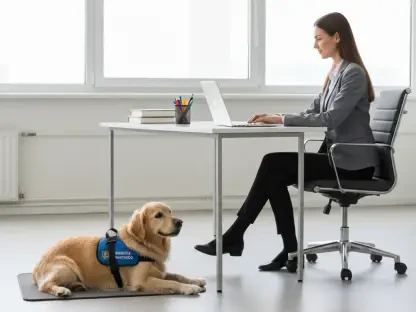Research conducted by CareCo, a UK mobility retailer, highlights the critical and often overlooked barriers faced by individuals with mobility needs when seeking employment. These barriers include inaccessible workplaces that lack essential features such as ramps or lifts for wheelchair users, disability parking that is either insufficient or nonexistent, and a general lack of awareness and positive attitudes towards people with mobility issues. These factors combine to create misconceptions about the capabilities of those with mobility needs, leading to differential treatment and discrimination.
Inaccessibility in the Workplace
Physical Barriers
Many workplaces are still not equipped to accommodate individuals with mobility needs, lacking essential infrastructure like ramps, lifts, and appropriately designed restrooms. These physical barriers not only hinder access but also create an unwelcoming environment for potential employees. For instance, a wheelchair user may face significant challenges just trying to enter an office building, let alone navigating it on a daily basis. This lack of accessibility directly excludes a section of talented individuals from the workforce, reducing diversity and innovation within the organization.
The issue of insufficient or nonexistent disability parking further exacerbates the problem. For many individuals with mobility needs, this lack of consideration means that getting to work can become a significant ordeal, adding stress and time to their daily routine. This oversight not only affects their ability to perform tasks efficiently but also their overall morale and job satisfaction. The physical design of workplaces must be reconsidered to ensure inclusivity and accessibility, creating an environment where all potential employees can thrive.
Attitudinal Barriers
Beyond physical barriers, there is a pervasive lack of awareness and positive attitudes towards individuals with mobility needs. Many employers and colleagues hold misconceptions about the abilities of people with mobility issues, often resulting in differential treatment either consciously or unconsciously. This lack of proper understanding can lead to missed opportunities and undervaluing the contributions that individuals with mobility needs can make within a workplace.
These attitudinal barriers manifest in various ways, from subtle biases during the hiring process to overt discrimination in daily interactions. Employers might hesitate to provide necessary accommodations, fearing additional costs or disruptions, despite reasonable adjustments being a legal requirement under the Equality Act. Moreover, this lack of awareness perpetuates a work culture that inadvertently sidelines individuals with mobility needs, further entrenching their marginalization. Addressing these attitudinal barriers is crucial to building a more inclusive and dynamic workforce.
Inflexible Working Hours
Challenges Posed by Standard Working Hours
In addition to physical and attitudinal barriers, inflexible working hours pose a significant challenge for individuals with mobility needs. For many, the standard 9-to-5 schedule is not feasible due to their specific requirements, which might include extended time for commuting, medical appointments, or the need for rest. This rigidity within working hours forces individuals to request adjustments that may seem outside the norm, even though such accommodations are mandated under the Equality Act.
This need for flexibility is often misunderstood or overlooked by employers, who may be reluctant to make changes to their established routines. However, by failing to accommodate these needs, businesses risk alienating potential employees who possess unique skills and perspectives that could benefit the organization. Furthermore, this lack of flexibility can lead to increased stress and burnout among employees with mobility needs, resulting in decreased productivity and higher turnover rates. Recognizing and addressing the need for flexible working hours is essential for fostering an inclusive and supportive work environment.
Benefits of Flexible Working Hours
CareCo’s research emphasizes the substantial benefits that employers derive from adopting flexible working hours. By adjusting schedules to accommodate the needs of employees with mobility issues, businesses can create a more inclusive and supportive work environment. This, in turn, promotes higher levels of job satisfaction and loyalty among staff, reducing turnover rates and the associated costs of hiring and training new employees.
Flexible working hours also allow employees with mobility needs to manage their time more effectively, leading to increased productivity and overall better performance. With the rise of remote work and telecommuting technologies, implementing flexible schedules has become more feasible than ever. Employers who embrace these changes can tap into a broader talent pool, gaining access to individuals who might otherwise be excluded due to rigid working hours. By recognizing and addressing these barriers, businesses not only support the well-being of their employees but also drive their own growth and success.
Conclusion
A study by CareCo, a UK-based mobility retailer, sheds light on the significant and often overlooked challenges faced by individuals with mobility needs when looking for employment. Key obstacles include workplaces that are not accessible, failing to provide essential features like ramps or lifts for wheelchair users. Additionally, there is often a lack of adequate disability parking, and sometimes it’s nonexistent altogether. Another major issue is the general lack of awareness and positive attitudes towards people with mobility issues. These factors collectively contribute to misconceptions about the abilities of those with mobility needs. Misunderstandings about their capabilities lead to differential treatment and discrimination in the workplace. The study emphasizes the need for better infrastructure and attitudes to create a more inclusive work environment for everyone, regardless of physical limitations. Promoting awareness and addressing these barriers are essential steps toward ensuring equal opportunities for individuals with mobility needs.









